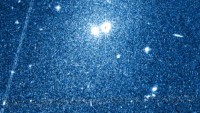Astronomers Discover Andromeda's Massive Gas Halo, Which Extends Near the Earth
| Marco Foronda | | May 10, 2015 11:05 PM EDT |
(Photo : Wikipedia)
Astronomers discovered a massive gas halo around Andromeda, the galaxy nearest the Milky Way, in an article published by The Astrophysical Journal last week.
The team spotted the halo through NASA's Hubble Space Telescope. They considered it as Andromeda's significant feature, being its gaseous atmosphere.
Like Us on Facebook
It extends one million lightyears away from the major galaxy, also called M31 or Messier 31 and about halfway to the Milky Way galaxy, near the Earth. In terms of size, it is 100 times wider in diameter than the moon.
The dispersed gas of this enormous halo contains about as much mass as half the stars in M31, according to lead researcher and University of Notre Dame's astrophysicist Nicolas Lehner. The reason for this is that a gaseous halo controls the rate of formation of stars inside galaxies.
However, the gas in the halo is invisible so the team had to use light from at least 18 quasars to estimate the halo's size and distance. Quasars are distant star-like objects that become extremely luminous because of gas build-up in massive black holes.
"As the light from the quasars travels toward Hubble, the halo's gas will absorb some of that light and make the quasar appear a little darker in just a very small wavelength range," the study's co-author J. Christopher Howk said.
The team then measured the dip in brightness to identify how much gas from M31 is present between each quasar and the Earth.
Halos around galaxies have been observed before, but not such a massive one very near the Earth, scientists noted.
If the Milky Way is also encircled by a massive halo, the two neighboring halos could merge before the predicted collision of the two galaxies. Scientists have recently studied that Andromeda and Milky Way would collide and form a new galaxy four billion years from now.
Andromeda Galaxy is 2.5 million lightyears from Milky Way and is 25 percent brighter. As the largest galaxy in the Local Group, a cluster of galaxies including our own and 45 others, it contains one trillion stars, which is twice the number present in the Milky Way.
Tagsandromeda, Milky Way, Galaxy, Stars, halo, gas, Hubble Space Telescope, NASA
©2015 Chinatopix All rights reserved. Do not reproduce without permission
EDITOR'S PICKS
-

Did the Trump administration just announce plans for a trade war with ‘hostile’ China and Russia?
-

US Senate passes Taiwan travel bill slammed by China
-

As Yan Sihong’s family grieves, here are other Chinese students who went missing abroad. Some have never been found
-

Beijing blasts Western critics who ‘smear China’ with the term sharp power
-

China Envoy Seeks to Defuse Tensions With U.S. as a Trade War Brews
-

Singapore's Deputy PM Provides Bitcoin Vote of Confidence Amid China's Blanket Bans
-

China warns investors over risks in overseas virtual currency trading
-

Chinese government most trustworthy: survey
-

Kashima Antlers On Course For Back-To-Back Titles
MOST POPULAR
LATEST NEWS
Zhou Yongkang: China's Former Security Chief Sentenced to Life in Prison

China's former Chief of the Ministry of Public Security, Zhou Yongkang, has been given a life sentence after he was found guilty of abusing his office, bribery and deliberately ... Full Article
TRENDING STORY

China Pork Prices Expected to Stabilize As The Supplies Recover

Elephone P9000 Smartphone is now on Sale on Amazon India

There's a Big Chance Cliffhangers Won't Still Be Resolved When Grey's Anatomy Season 13 Returns

Supreme Court Ruled on Samsung vs Apple Dispute for Patent Infringement

Microsoft Surface Pro 5 Rumors and Release Date: What is the Latest?











